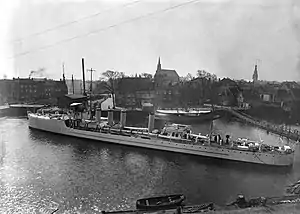Wolf-class destroyer
The Wolf- or Fret-class destroyers, also known as the Roofdier-class, lit. "predator",[A 1] were a class of eight destroyers that were built between 1910 and 1913 for the Royal Netherlands Navy to serve in the Dutch East Indies. They were the first Dutch destroyers built after a British design. The first six ships were built by Koninklijke Schelde Groep De Schelde shipyards in Vlissingen, and the last two by Fijenoord in Rotterdam. The ships were replaced at the end of the 1920s by the Admiralen class.[1]
 HNLMS Wolf c. 1912 | |
| Class overview | |
|---|---|
| Name: | Wolf-class destroyer |
| Builders: |
|
| Operators: |
|
| Succeeded by: | Admiralen class |
| Built: | 1910-1913 |
| In commission: | 1911-1928 |
| Completed: | 8 |
| Retired: | 8 |
| General characteristics | |
| Type: | Destroyer |
| Displacement: | 510 tonnes (500 long tons) |
| Length: | 70.5 m (231 ft) o.a. |
| Beam: | 6.6 m (22 ft) |
| Draught: | 2.8 m (9 ft 2 in) |
| Installed power: |
|
| Propulsion: |
|
| Speed: | 30 kn (56 km/h; 35 mph) |
| Range: |
|
| Complement: | 83 |
| Armament: |
|
Design
The ships displaced 510 t (502 long tons) and measured 70.4 m (231 ft) in overall length, a 6.6 m (22 ft) breadth, with a 2 m (6 ft 7 in) draught. They were powered by four Yarrow boilers installed that produced 8,500 hp (6,300 kW). They had two Krupp-Germania steam turbines that drove two shafts. The first four ships, Wolf, Fret, Bulhond, and Jakhals, each carried 120 t (120 long tons; 130 short tons) of coal, the last four, Lynx, Hermelijin, Vos, and Panter, carried an additional 12.5 t (12.3 long tons; 13.8 short tons) of fuel oil in addition to the 120t of coal. This gave the last four ships an additional 340 nmi (630 km; 390 mi) of endurance.
The ships were armed with four 75 mm (3 in)/52 caliber guns, four 7.92 mm (0.31 in)/80 caliber machine guns, and two 450 mm (18 in) torpedo tubes.
Ships
| Name | Laid down | Launched | Completed | Builder | Fate |
|---|---|---|---|---|---|
| Wolf | 1909 | 17 September 1910 | 1911 | Koninklijke Maatschappij de Schelde, Flushing | Stricken 1924 |
| Fret | 1909 | 15 October 1910 | 1911 | Koninklijke Maatschappij de Schelde, Flushing | Stricken 1922 |
| Bulhond | 1910 | 20 December 1911 | August 1912 | Koninklijke Maatschappij de Schelde, Flushing | Stricken 1927 |
| Jakhals | 1910 | 20 January 1912 | July 1912 | Koninklijke Maatschappij de Schelde, Flushing | Stricken 1928 |
| Hermelijn | 1911 | 22 February 1913 | July 1913 | Koninklijke Maatschappij de Schelde, Flushing | Stricken 1925 |
| Lynx | 1911 | 24 December 1912 | July 1913 | Koninklijke Maatschappij de Schelde, Flushing | Stricken 1928 |
| Vos | 1912 | 28 June 1913 | February 1914 | Feijenoord, Schiedam | Stricken 1928 |
| Panter | 1912 | 9 September 1913 | March 1914 | Feijenoord, Schiedam | Stricken 1934 |
They are named after mammals of the order Carnivora (Roofdieren is a synonym for carnivore in Dutch). Their names in English, in the sequence listed, mean: wolf, ferret, bulldog, jackal, ermine, lynx, fox and panther.
Notes
- From Danish: roof, "robbery" and dier, "animal". See the Wiktionary article for more information.
References
- Gardiner, Robert, ed. (1985). Conway's All the World's Fighting Ships, 1906-1921. Naval Institute Press. ISBN 9780870219078.CS1 maint: ref=harv (link)
- "ROYAL DUTCH NAVY (NETHERLANDS)-Torpedo Ships-FRET destroyers (1911-1914)". Retrieved 11 September 2018.